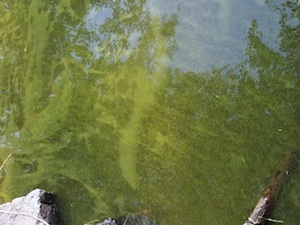Gloeotrichia, a type of blue-green algae, has recently appeared in the Belgrade Lakes as a variable green blush on the water. Roy Bouchard, formerly of the Maine Department of Environmental Protection (DEP), introduces the issue. DEP, BLA, and Colby College are collaborating to learn more about this mysterious organism.

Gloeotrichia Algae: Great and Long Ponds
By Roy Bouchard, formerly with the Maine Dept. Environmental Protection
The small, fuzzy green dots that appear in many lakes during summer are called Gloeotrichia echinulata. Though technically a cyanobacterium, it’s often grouped with algae. It typically arrives mid-summer and disappears quickly. However, recent years have seen earlier appearances and longer-lasting blooms in Great and Long Ponds.
Historically, Gloeotrichia has been present in many Maine lakes, including those with excellent water quality. It grows on sediment in shallow areas where light reaches the lake bottom. These colonies absorb phosphorus from the sediment, and when mature, rise to the surface and reproduce. Wind can concentrate them in coves and shorelines.
While not toxic, some people may experience skin irritation or upset stomach if water is ingested. Children should be reminded not to swallow lake water while swimming.
Controlling Gloeotrichia is difficult. Treatments like aluminum sulfate are not practical for large lakes, and chemical solutions are environmentally harmful. However, managing runoff and reducing phosphorus inputs can help limit long-term growth.
Ongoing research in partnership with Colby College is helping us understand Gloeotrichia’s lifecycle and long-term effects. Preventing phosphorus pollution remains our best defense.
Related Documents
More Resources
Great Pond: Water Quality Analysis
Long Pond: Water Quality Analysis